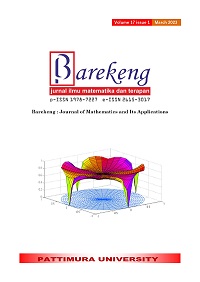INTRODUCTION OF PAPUAN AND PAPUA NEW GUINEAN FACE PAINTING USING A CONVOLUTIONAL NEURAL NETWORK
Abstract
In this research, the face painting recognition of Papua and Papua New Guinea was identified using the Convolutional Neural Network (CNN). This CNN method is one of the deep learning that is very well known and widely used in face recognition. The best training process model is obtained using the CNN architecture, namely ResNet-50, VGG-16, and VGG-19. The results obtained from the training model obtained an accuracy of 80.57% for the ResNet-50 model, 100% for the VGG-16 model, and 99.57% for the VGG-19 model. After the training process, predictions were continued using architectural models with test data. The prediction results obtained show that the accuracy of the ResNet-50 model is 0.70, the VGG-16 model is 0.82, and the VGG-19 model is 0.83. It means that the CNN architectural model that has the best performance in making predictions in identifying the recognition of Papua and Papua New Guinea's face painting is the VGG-19 model because the accuracy value obtained is 0.83.
Downloads
References
I. Peradantha and M. Murda, “KAJIAN BENTUK, SUMBER INSPIRASI DAN MAKNA SIMBOLIS MOTIF BODY PAINTING ETNIS PADAIDO DI PAPUA,” J. Arkeol. Papua, vol. Vol. 12 Ed, no. Juni, pp. 43–59, 2020.
Syamsiar, “EKSPLORASI TEKNIK FACE AND BODY PAINTING UNTUK MENAMBAH ARTISTIK PAGELARAN BATIK FASHION ART WEAR,” Brikolase, vol. 10, no. 1, 2018.
A. Savoiu and J. Wong, “Recognizing Facial Expressions Using Deep Learning,” p. 67, 2017, [Online]. Available: http://cs231n.stanford.edu/reports/2017/pdfs/224.pdf.
A. Rohim, Y. A. Sari, and Tibyani, “Convolution neural network (cnn) untuk pengklasifikasian citra makanan tradisional,” J. Pengemb. Teknol. Inf. dan Ilmu Komput., vol. 3, no. 7, pp. 7038–7042, 2019, [Online]. Available: http://j-ptiik.ub.ac.id/index.php/j-ptiik/article/view/5851/2789.
D. R. . Talwekar, R. K. Jaiswal, N. Sharma, and D. S. Jain, “Evolutional of Vgg16 and Resnet50 Using Transfer Learning With Classification Plant Disease,” Gedrag Organ. Rev., vol. 33, no. 04, pp. 327–334, 2020, doi: 10.37896/gor33.04/031.
D. Theckedath and R. R. Sedamkar, “Detecting Affect States Using VGG16, ResNet50 and SE-ResNet50 Networks,” SN Comput. Sci., vol. 1, no. 2, pp. 1–7, 2020, doi: 10.1007/s42979-020-0114-9.
M. Ibsen, C. Rathgeb, T. Fink, P. Drozdowski, and C. Busch, “Impact of facial tattoos and paintings on face recognition systems,” IET Biometrics, Apr. 2021, doi: 10.1049/bme2.12032.
N. K. C. PRATIWI, N. IBRAHIM, Y. N. FU’ADAH, and S. RIZAL, “Deteksi Parasit Plasmodium pada Citra Mikroskopis Hapusan Darah dengan Metode Deep Learning,” ELKOMIKA J. Tek. Energi Elektr. Tek. Telekomun. Tek. Elektron., vol. 9, no. 2, p. 306, 2021, doi: 10.26760/elkomika.v9i2.306.
O. Nurima Putri, “Implementasi Metode Cnn Dalam Klasifikasi Gambar Jamur Pada Analisis Image Processing (Studi Kasus: Gambar Jamur Dengan Genus Agaricus Dan Amanita),” 2020.
S. Tammina, “Transfer learning using VGG-16 with Deep Convolutional Neural Network for Classifying Images,” Int. J. Sci. Res. Publ., vol. 9, no. 10, p. p9420, 2019, doi: 10.29322/ijsrp.9.10.2019.p9420.
A. Goodfellow, Ian; Bengio, Yosua; Courvile, Deep Learning, vol. 8, no. 9. 2017.
A. Victor Ikechukwu, S. Murali, R. Deepu, and R. C. Shivamurthy, “ResNet-50 vs VGG-19 vs training from scratch: A comparative analysis of the segmentation and classification of Pneumonia from chest X-ray images,” Glob. Transitions Proc., vol. 2, no. 2, pp. 375–381, 2021, doi: 10.1016/j.gltp.2021.08.027.
M. R. Alwanda, R. P. K. Ramadhan, and D. Alamsyah, “Implementasi Metode Convolutional Neural Network Menggunakan Arsitektur LeNet-5 untuk Pengenalan Doodle,” J. Algoritm., vol. 1, no. 1, pp. 45–56, 2020, doi: 10.35957/algoritme.v1i1.434.
K. H. Mahmud, Adiwijaya, and S. Al Faraby, “Klasifikasi Citra Multi-Kelas Menggunakan Convolutional Neural Network,” e-Proceeding Eng., vol. 6, no. 1, pp. 2127–2136, 2019.
M. Hasnain, M. F. Pasha, I. Ghani, M. Imran, M. Y. Alzahrani, and R. Budiarto, “Evaluating Trust Prediction and Confusion Matrix Measures for Web Services Ranking,” IEEE Access, vol. 8, no. July, pp. 90847–90861, 2020, doi: 10.1109/ACCESS.2020.2994222.
W. Setiawan, “Perbandingan Arsitektur Convolutional Neural Network Untuk Klasifikasi Fundus,” J. Simantec, vol. 7, no. 2, pp. 48–53, 2020, doi: 10.21107/simantec.v7i2.6551.
S. Namani, L. S. Akkapeddi, and S. Bantu, “Performance Analysis of VGG-19 Deep Learning Model for COVID-19 Detection,” 2022 9th Int. Conf. Comput. Sustain. Glob. Dev., pp. 781–787, 2022, doi: 10.23919/INDIACom54597.2022.9763177.
Copyright (c) 2023 Happy Alyzhya Haay, Suryasatriya Trihandaru, Bambang Susanto

This work is licensed under a Creative Commons Attribution-ShareAlike 4.0 International License.
Authors who publish with this Journal agree to the following terms:
- Author retain copyright and grant the journal right of first publication with the work simultaneously licensed under a creative commons attribution license that allow others to share the work within an acknowledgement of the work’s authorship and initial publication of this journal.
- Authors are able to enter into separate, additional contractual arrangement for the non-exclusive distribution of the journal’s published version of the work (e.g. acknowledgement of its initial publication in this journal).
- Authors are permitted and encouraged to post their work online (e.g. in institutional repositories or on their websites) prior to and during the submission process, as it can lead to productive exchanges, as well as earlier and greater citation of published works.






1.gif)



